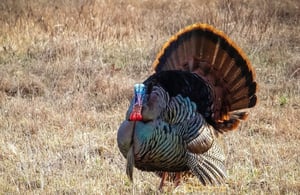
Spring Turkey Prep Pt. 2
Your scouting is done and you’ve learned how to harvest a turkey—but do you really understand the biology of your target? Here are some turkey facts and mannerisms to help give you some insight.

How to Tell a Hen from a Tom Turkey
First, you need to be able to distinguish between male and female wild turkeys so you can tell them apart. In most states, only turkeys with a “beard” of feathers protruding from the middle of their chest can be hunted during the Spring season. Most of bearded birds are males, which leaves the females safe to breed. Telling a male from a female can be a little tricky if you don’t know the signs to look for, though.
Female turkeys, also known as hens, have a smaller, grayish-blue head with less pronounced caruncles (also called waddles) at the base of their necks. A hen’s feathers also appear duller and lack the vibrant iridescent tips males' feathers have. About 10% of hens have a beard and some do gobble, although their calls sound strained when compared to that of a male.
A male turkey, also known as a tom, has a larger body that looks almost black with brilliant iridescent feather tips. Toms have a pronounced beard, plus spurs on their legs. These are used for fighting rival males in their pursuit of dominance. 
A tom’s head is very fleshy with a red, white, and blue coloration that can change according to their mood. A male turkey’s caruncles get pronounced and turn bright red if they become agitated at a rival or when sexually aroused. Toms also have a white "crown" that sits on the top of their heads. The coloration around the eyes turns a blueish color and can sometimes have a purple hue.
If you hear gobbling, that’s most likely a tom, as that’s the mating call of the male turkey. Hens yelp—and this can be a source of confusion among some hunters.
Understanding Turkey Behavior and Signs of Alertness
All turkeys have a snood, which is the long piece of flesh that hangs over their beaks. If the snood is hanging down loosely, the bird is at ease. If it is erect, they are cautious and will be extra alert. Anyone that has ever had a gobbler come in sees the snood go from hanging down to being sucked back in knows the jig is up.
Turkeys have exceptionally acute eyes and ears. These serve as their primary security alarms, so stay quiet and hidden if you want a successful hunt!
Turkeys have flattened corneas and can see red, green, blue, and ultra-violet to some degree. Dress accordingly and you’ll be harder for them to spot. A turkey’s eyes are located on the side of their head. This means they have monocular periscopic vision, which is four times better than 20/20, and just over 270 degrees of peripheral vision that can detect the smallest movement from long distance.
Where to Find Turkeys
When the foliage is light, turkeys will be found in the timber and in wide-open fields and cuts. When it rains, they head out into openings, as the rain compromises their hearing. If there is rain in the forecast, set up on a field and wait them out.
It is easier to call a turkey uphill than downhill. If you need to call them downhill, that’s possible, just be prepared to wait!
Turkeys tend to roost on southeastern facing slopes so they can catch the first rays of warming sun. Young gobblers or "jakes" and subdominant toms are generally easier to call than an old wood-wise mature tom will be.
Knowing and understanding the habits of turkeys can make the difference between a frustrating hunt and a successful one. Here’s wishing you a successful harvest!
.png?width=1200&name=MicrosoftTeams-image%20(6).png)
